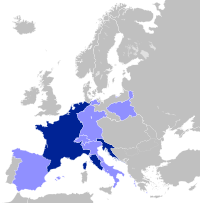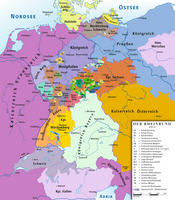Kingdom of Westphalia
This article needs additional citations for verification. (November 2011) |
Kingdom of Westphalia | ||
|---|---|---|
| 1807–1813 | ||
| Motto: Character und Aufrichtigkeit "Character and Honesty" | ||
Calvinism Judaism (minority) | ||
| Government | Constitutional monarchy | |
| King | ||
• 1807–1813 | Jérôme Bonaparte | |
Joseph Jérôme, Comte Siméon | ||
| Legislature | Treaty of Tilsit | 7 July 1807 |
| 7 December 1807 | ||
| 19 October 1813 | ||
| Area | ||
| 1809 | 37,883 km2 (14,627 sq mi) | |
| 1810 | 63,652 km2 (24,576 sq mi) | |
| 1812 | 45,427 km2 (17,539 sq mi) | |
| Population | ||
• 1809 | 1,950,724 | |
• 1810 | 2,600,000 | |
• 1812 | 2,065,970 | |
| Currency | Westphalian frank | |
| Today part of | Germany | |
The Kingdom of Westphalia was a client state of France in present-day Germany that existed from 1807 to 1813. While formally independent, it was ruled by Napoleon's brother Jérôme Bonaparte. It was named after Westphalia, but this was a misnomer since the kingdom had little territory in common with that area. The region mostly covered territory formerly known as Eastphalia.
Napoleon imposed the first written modern constitution in Germany, a French-style central administration, and agricultural reform. The kingdom liberated the serfs and gave everyone equal rights and the right to a jury trial. In 1808 the kingdom passed Germany's first laws granting Jews equal rights, thereby providing a model for reform in the other German states. Westphalia seemed to be progressive in immediately enacting and enforcing the new reforms.
The country was relatively poor but Napoleon demanded heavy taxes and payments and conscripted soldiers. Few of the men who
Formation

The Kingdom of Westphalia was created by Napoleon in 1807 by merging territories ceded by the
Since it was intended as a Napoleonic "
The organisers used French terms to designate the regional territories within the kingdom: departments received names based on watercourses (Elbe, Saale, Weser, Fulda, Leine, Oker) and mountains (Harz), regardless of their traditional names. These departments were generally composed of territories taken from a number of petty states. Compared to the departments of France itself, the Westphalian departments were relatively small and sparsely populated.[2]
While administrative divisions (departments, districts and cantons) were certainly less unequal than the previous territorial divisions, uniformity does not appear to have been a determining factor in their creation. The desire to break from the past, and not just from the random territorial divisions of the former manorial justices, especially influenced the cantonal distribution.[2] Just as before the conquest, freedom of expression remained curtailed and censorship was instituted. In December 1810 the coastal and northern départements North (capital: Stade) and Lower Elbe (capital: Lunenburg) were ceded to the French Empire.
Jews
Following the French example, Jewish congregations were reorganised and a
Russian conquest
A significant burden on the kingdom was the requirement to supply troops and financial support for the
In September 1813, Russian troops surrounded Cassel, defeated the French completely, and took the city. By October 1 they had conquered the whole kingdom, but three days later Jérôme returned with French soldiers and managed to recapture Cassel. The Elector of Hesse-Kassel arrived soon after and the Russians besieged the city again. After France lost the Battle of Leipzig on 19 October 1813, the Russians dissolved the kingdom and restored the status quo of 1806 except for Rietberg and Stolberg-Wernigerode, which went to Prussia.
Coat of arms

The arms reflect the incorporated territories. The first quarter shows the silver horse of
See also
- Duchy of Westphalia
- Province of Westphalia
- Karl Keller, prominent court musician of the Kingdom of Westphalia
References
- ISBN 9780029066003.
- ^ ISBN 978-0-230-24131-2.




